fuel CHEVROLET PRIZM 1998 3.G Owners Manual
[x] Cancel search | Manufacturer: CHEVROLET, Model Year: 1998, Model line: PRIZM, Model: CHEVROLET PRIZM 1998 3.GPages: 364, PDF Size: 18.79 MB
Page 11 of 364
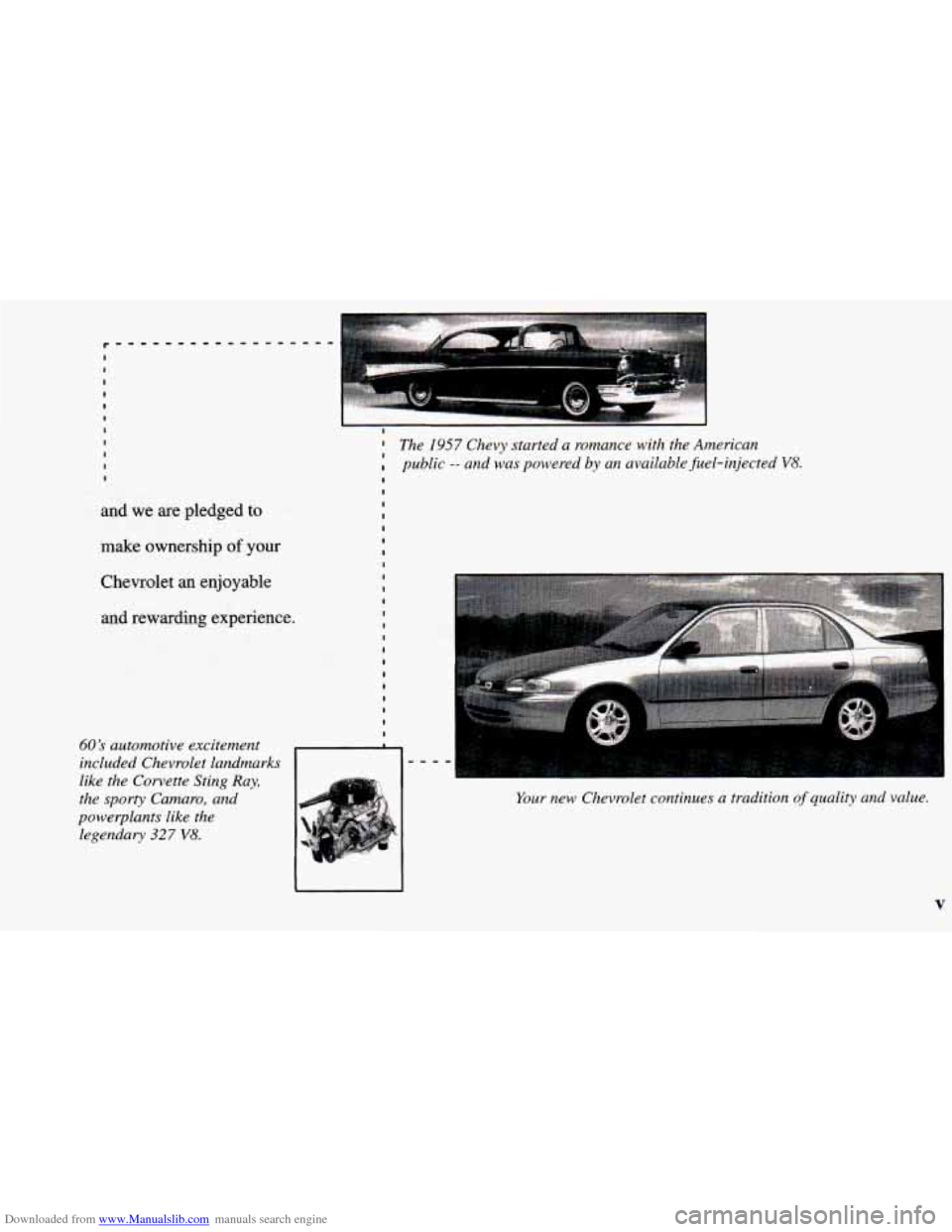
Downloaded from www.Manualslib.com manuals search engine I
I
I
I I
I
I
I
I I l
and we are pledged to
make ownership of your
Chevrolet an enjoyable and rewarding experience.
60's automotive excitement
included Chevrolet landmarks
like the Corvette Sting Ray,
the sporty Camaro, and
powerplants like the
legendary
327 V8.
L
I The 1957 Chevy started a romance with the American
I public -- and was powered by an available fuel-injected V8. I
I I I I I I I I I I I I I I I I I I I I I I I
J
Your new Chevrolet continues a tradition of quality and value.
V
Page 14 of 364
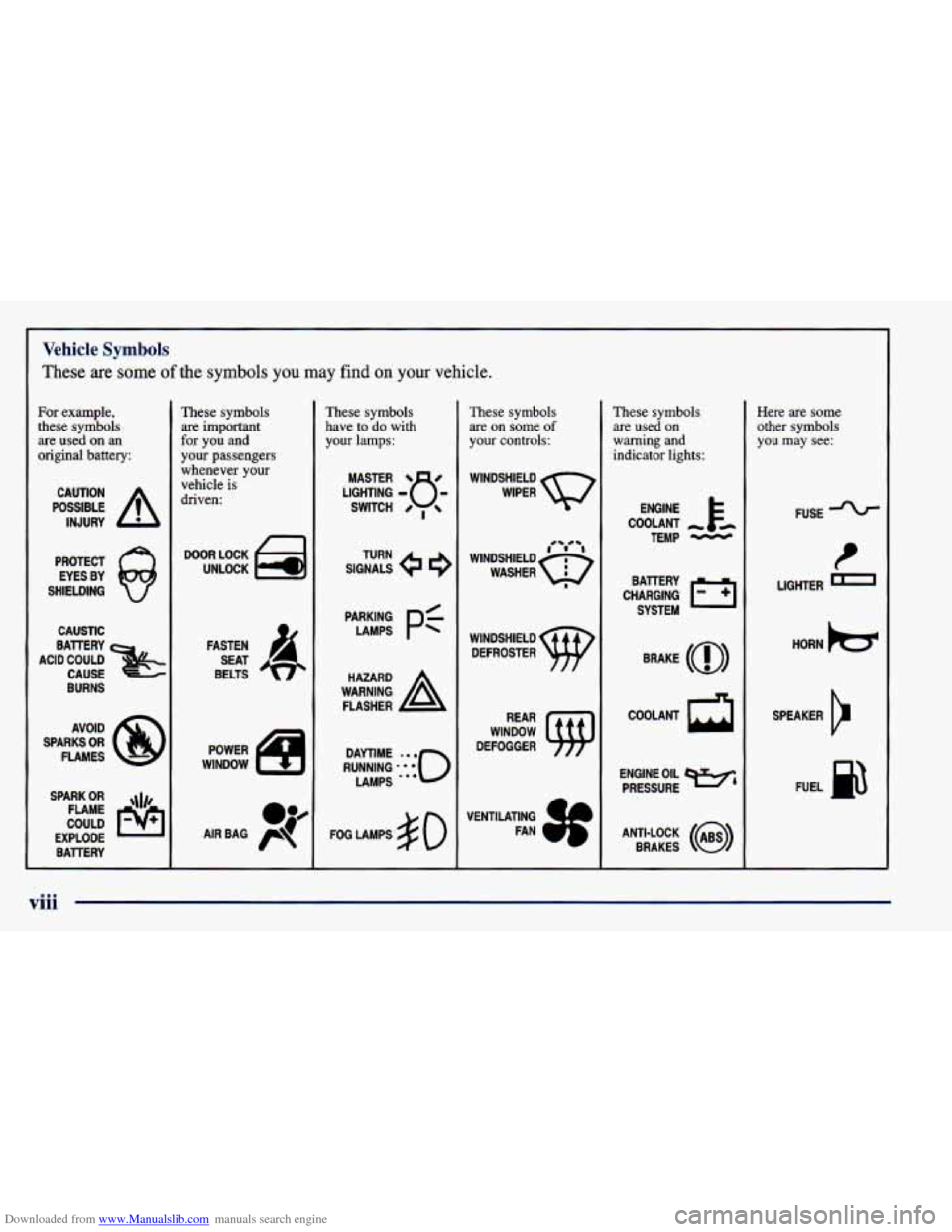
Downloaded from www.Manualslib.com manuals search engine Vehicle Symbols
These are some of the symbols you may find on your vehicle.
For example,
these symbols
are used
on an
original battery:
POSSIBLE A
CAUTION
INJURY
PROTECT EYES BY
SHIELDING
Q
CAUSTIC
ACID COULD BATTERY
CAUSE
BURNS
AVOID
SPARKS
OR
FLAMES
SPARK
OR ,111,
COULD FLAME
EXPLODE BATTERY
These symbols are important
for you and
your passengers whenever your
vehicle
is
driven:
DOOR LOCK
UNLOCK
FASTEN SEAT
BELTS
These symbols
have to do with
your lamps:
SIGNALS e e
TURN
FOG LAMPS
$0
These symbols are
on some of
your controls:
WINDSHIELD
WIPER
WINDSHIELD DEFROSTER
WINDOW
DEFOGGER
VENTILATING FAN
These symbols are used on
warning and
indicator lights:
ENGINE t
COOLANT t- TEMP -
CHARGING I-1
BATTERY
SYSTEM
BRAKE
(0)
COOLANT a
ENGINE OIL w,
PRESSURE
ANTI-LOCK
(8)
BRAKES
Here are some
other symbols
you may see:
FUSE
LIGHTER
a
HORN )tr
SPEAKER
b
FUEL p3
viii
Page 94 of 364
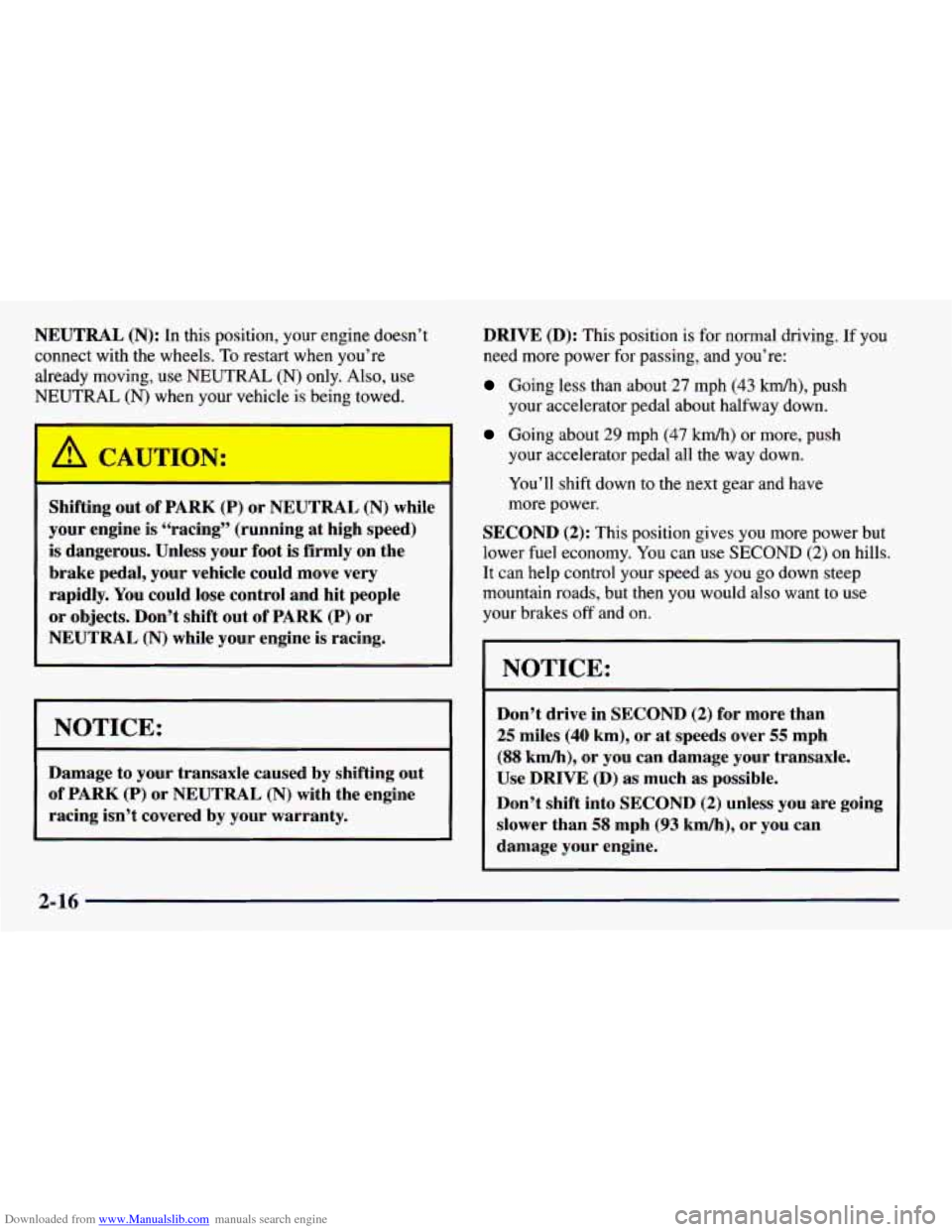
Downloaded from www.Manualslib.com manuals search engine NEUTRAL (N): In this position, your engine doesn’t
connect with the wheels.
To restart when you’re
already moving,
use NEUTRAL (N) only. Also, use
NEUTRAL (N) when your vehicle is being towed.
Shifting out of PARK (P) or NEUTRAL (N) while
your engine is “racing” (running at high speed)
is dangerous. Unless your foot
is firmly on the
brake pedal, your vehicle could move very
rapidly. You could lose control and hit people
or objects. Don’t shift out of PARK (P) or
NEUTRAL
(N) while your engine is racing.
NOTICE:
Damage to your transaxle caused by shifting out
of PARK
(P) or NEUTRAL (N) with the engine
racing isn’t covered by your warrantv. DRIVE (D):
This
position is for normal driving. If you
need more power for passing, and you’re:
Going less than about 27 mph (43 M), push
your accelerator pedal about halfway down.
Going about 29 mph (47 kmh) or more, push
your accelerator pedal all the way down.
You’ll shift down to the
next gear and have
more power.
SECOND (2): This position gives you more power but
lower fuel economy.
You can use SECOND (2) on hills.
It can help control your speed as you go down steep
mountain roads, but then you would also want to use
your brakes
off and on.
-- ~~
NOTICE:
Don’t drive in SECOND (2) for more than
25 miles (40 km), or at speeds over 55 mph
(88 kmh), or you can damage your transaxle.
Use DRIVE (D) as much as possible.
Don’t shift into SECOND
(2) unless you are going
slower than
58 mph (93 km/h), or you can
damage your engine.
2-16
Page 95 of 364
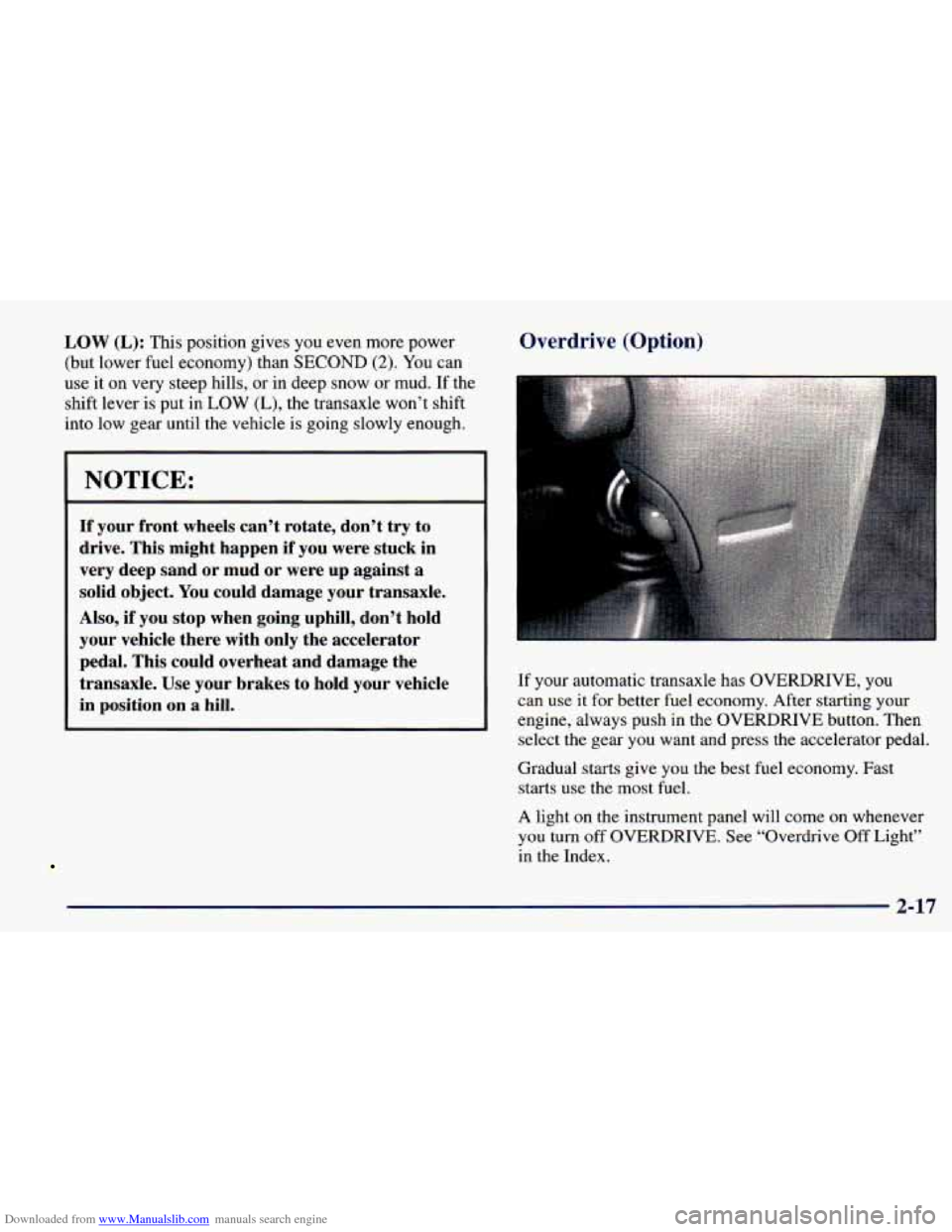
Downloaded from www.Manualslib.com manuals search engine LOW (L): This position gives you even more power
(but lower fuel economy) than SECOND
(2). You can
use it on very steep hills,
or in deep snow or mud. If the
shift lever is put in
LOW (L), the transaxle won’t shift
into low gear until the vehicle is going slowly enough.
I NOTICE.
If your front wheels can’t rotate, don’t try to
drive. This might happen
if you were stuck in
very deep sand or mud or were up against
a
solid object. You could damage your transaxle.
Also, if you stop when going uphill, don’t hold
your vehicle there with only the accelerator
’ pedal. This could overheat and damage the
1 transaxle. Use your brakes to hold your vehicle
~ in position on a hill.
Overdrive (Option)
If your automatic transaxle has OVERDRIVE, you
can use it for better fuel economy. After starting your
engine, always push in the OVERDRIVE button. Then
select the gear you want and press the accelerator pedal.
Gradual starts give you the best fuel economy. Fast
starts use the most fuel.
A light on the instrument panel will come on whenever
you turn
off OVERDRIVE. See “Overdrive Off Light”
in the Index.
2-17
Page 97 of 364
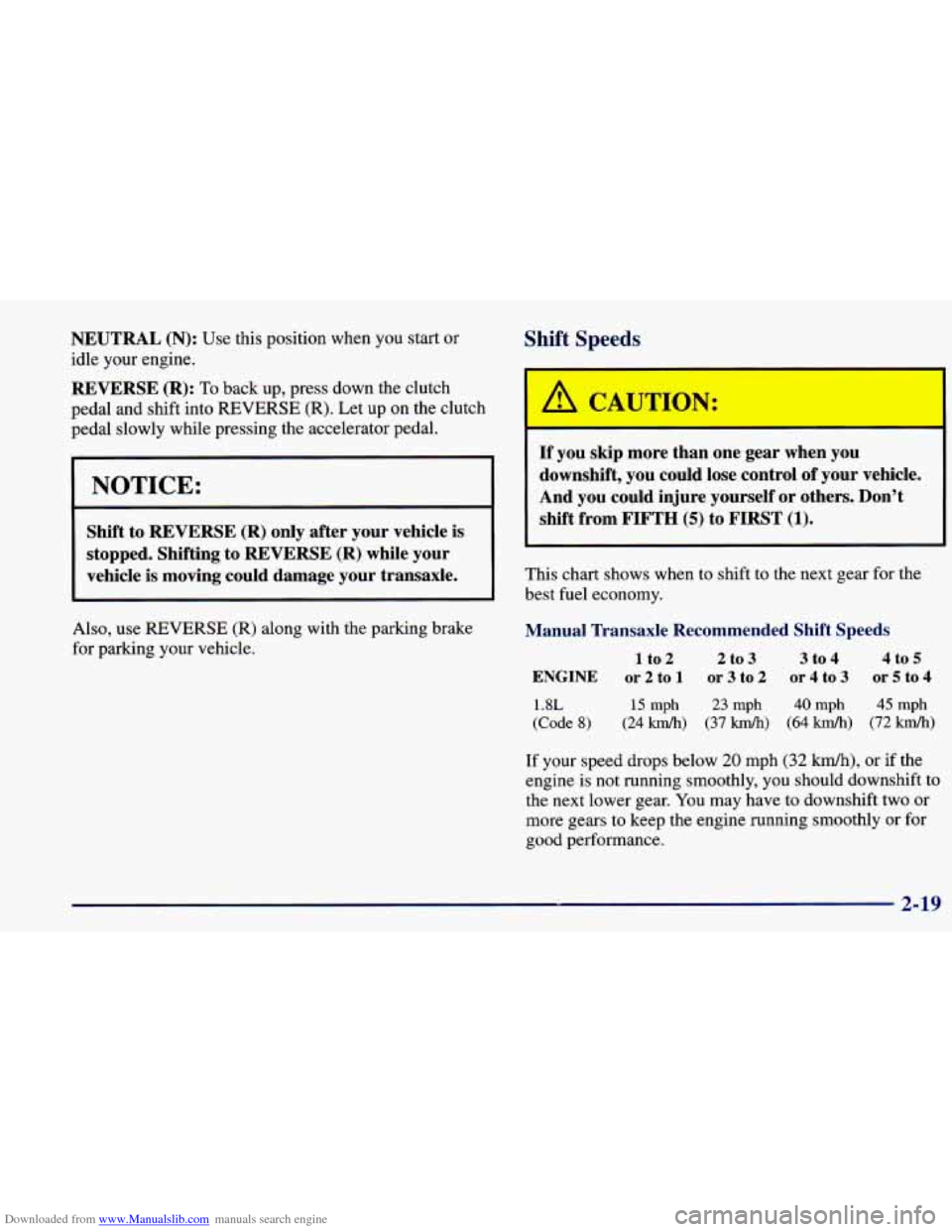
Downloaded from www.Manualslib.com manuals search engine NEUTRAL (N): Use this position when you start or
idle your engine.
REVERSE (R): To back up, press down the clutch
pedal and shift into REVERSE
(R). Let up on the clutch
pedal slowly while pressing the accelerator pedal.
NOTICE:
Shift to REVERSE (R) only after your vehicle is
stopped. Shifting to REVERSE
(R) while your
vehicle is moving could damage your transaxle.
Shift Speeds
Also, use REVERSE (R) along with the parking brake
for parking your vehicle.
-
A CAUTICY:
If you skip more tl n one gear when you
downshift, you could lose control of your vehicle.
And you could injure yourself or others. Don’t
shift from FIFTH
(5) to FIRST (1).
This chart shows when to shift to the next gear for the
best fuel economy.
Manual Transaxle Recommended Shift Speeds
ENGINE
1.8L
(Code 8)
1 to 2 2 to 3 3 to 4 4
to 5
or2to1 or3to2 or4to3
orst04
15 mph 23 mph 40 mph 45 mph
(24 km/h) (37 km/h) (64 kmk) (72 km/h)
If your speed drops below 20 mph (32 km/h), or if the
engine is not running smoothly, you should downshift to
the next lower gear.
You may have to downshift two or
more gears to keep the engine running smoothly or for
good performance.
2-19
Page 111 of 364
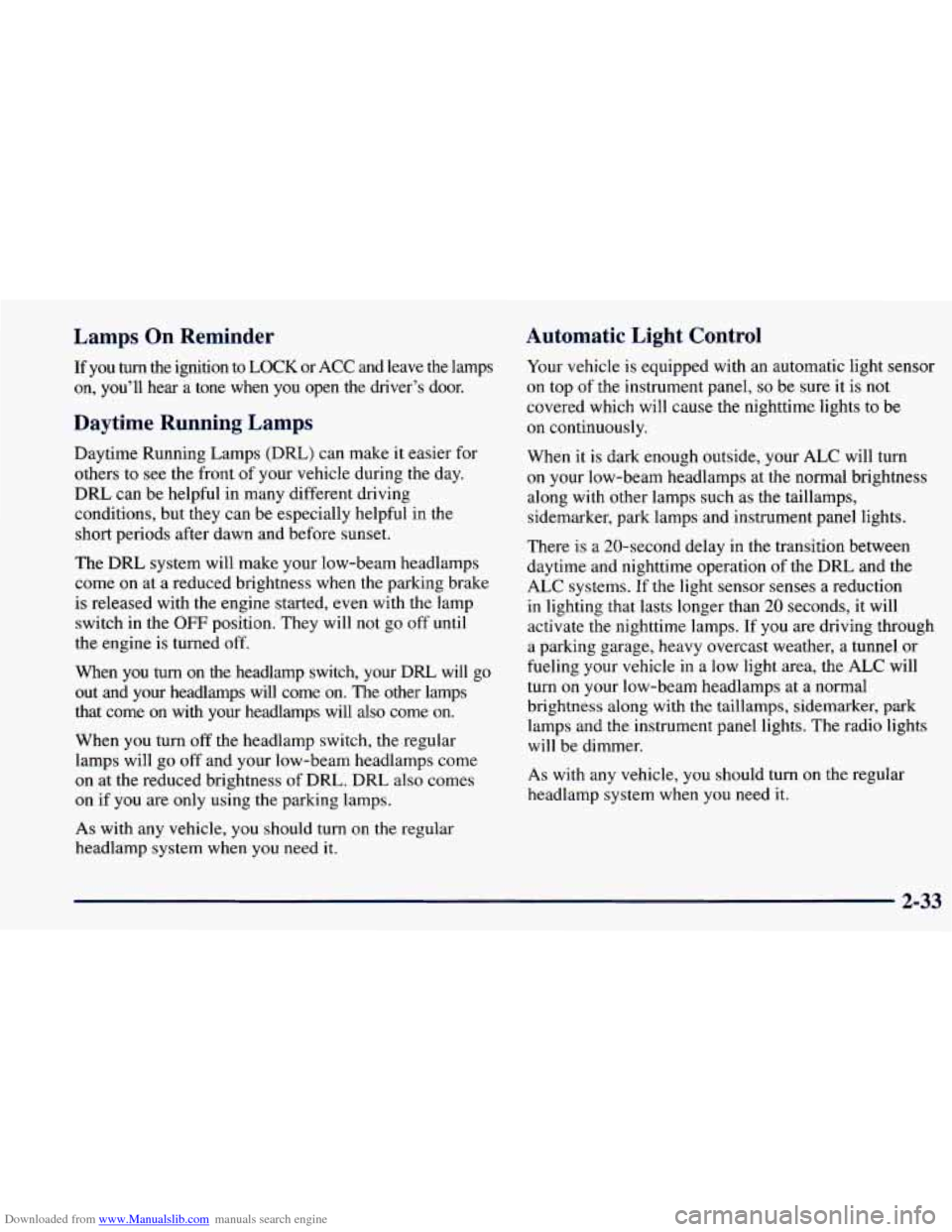
Downloaded from www.Manualslib.com manuals search engine Lamps On Reminder
If you turn the ignition to LOCK or ACC and leave the lamps
on, you’ll hear a tone when you open the driver’s door.
Daytime Running Lamps
Daytime Running Lamps (DRL) can make it easier for
others to
see the front of your vehicle during the day.
DRL can be helpful in many different driving
conditions, but they can be especially helpful in
the
short periods after dawn and before sunset.
The DRL system will make your low-beam headlamps
come on at a reduced brightness when the parking brake
is released with the engine started, even with the lamp
switch in the
OFF position. They will not go off until
the engine is turned off.
When you
turn on the headlamp switch, your DRL will go
out and your headlamps will come on. The other lamps
that come on with your headlamps will also come on.
When you turn
off the headlamp switch, the regular
lamps will go off and your low-beam headlamps come
on at the reduced brightness of DRL. DRL also comes
on if you are only using the parking lamps.
As with any vehicle, you should turn on the regular
headlamp system when you need
it.
Automatic Light Control
Your vehicle is equipped with an automatic light sensor
on top of the instrument panel, so be sure it is not
covered which will cause the nighttime lights to be
on continuously.
When
it is dark enough outside, your ALC will turn
on your low-beam headlamps at the normal brightness
along with other lamps such as the taillamps,
sidemarker, park lamps and instrument panel lights.
There is
a 20-second delay in the transition between
daytime and nighttime operation of the DRL and the
ALC systems. If the light sensor senses a reduction
in lighting that lasts longer than
20 seconds, it will
activate the nighttime lamps. If you are driving through
a parking garage, heavy overcast weather, a tunnel or
fueling your vehicle in a low light area, the ALC will
turn on your low-beam headlamps at a normal
brightness along with the taillamps, sidemarker, park
lamps and the instrument panel lights. The radio lights
will be dimmer.
As with any vehicle, you should turn on the regular
headlamp system when you need it.
2-33
Page 120 of 364
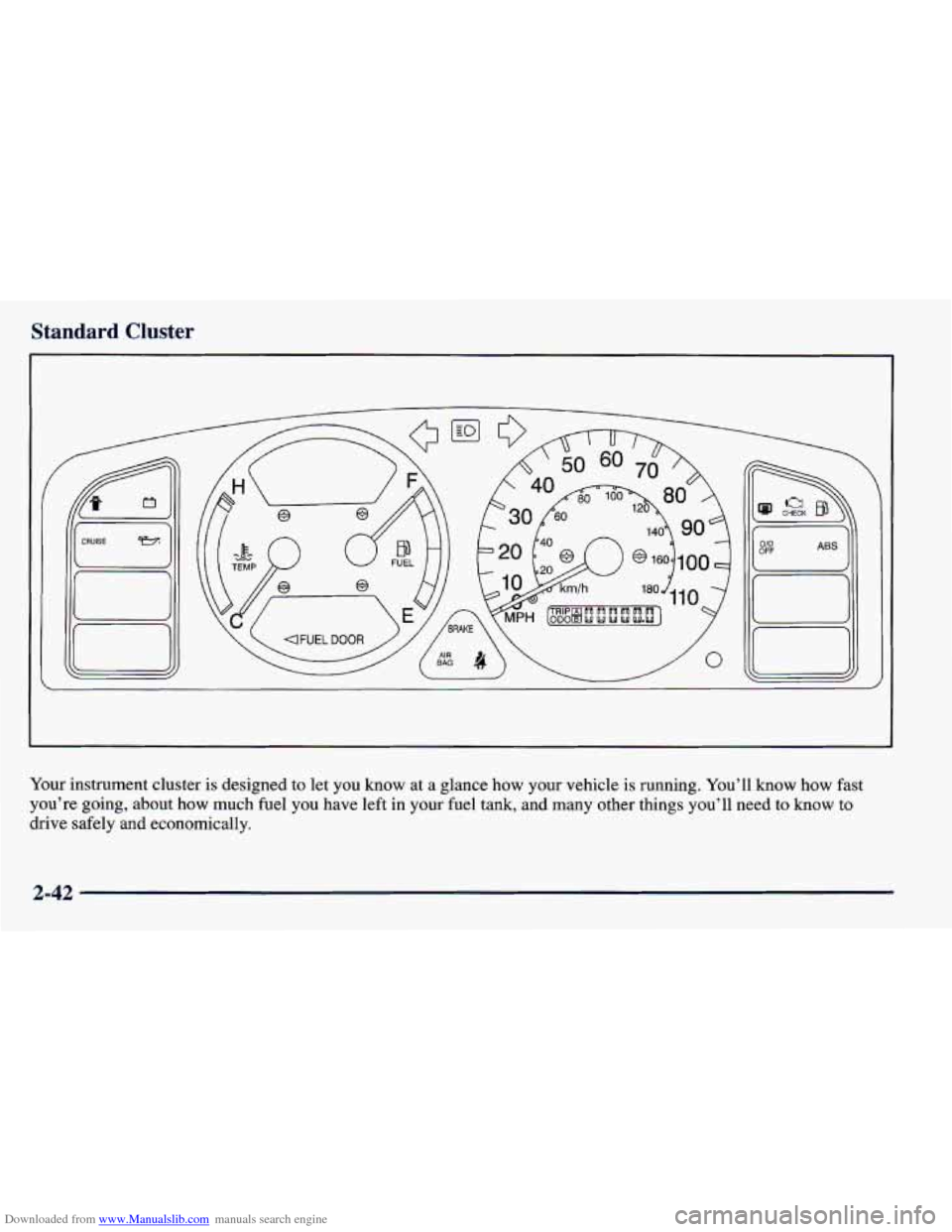
Downloaded from www.Manualslib.com manuals search engine Standard Cluster
Your instrument cluster is designed to let you know at a glance how your vehicle is running. You’ll know how fast
you’re going, about how much fuel you have left in your fuel tank, and many other things you’ll need
to know to
drive safely
and economically.
2-42
Page 121 of 364
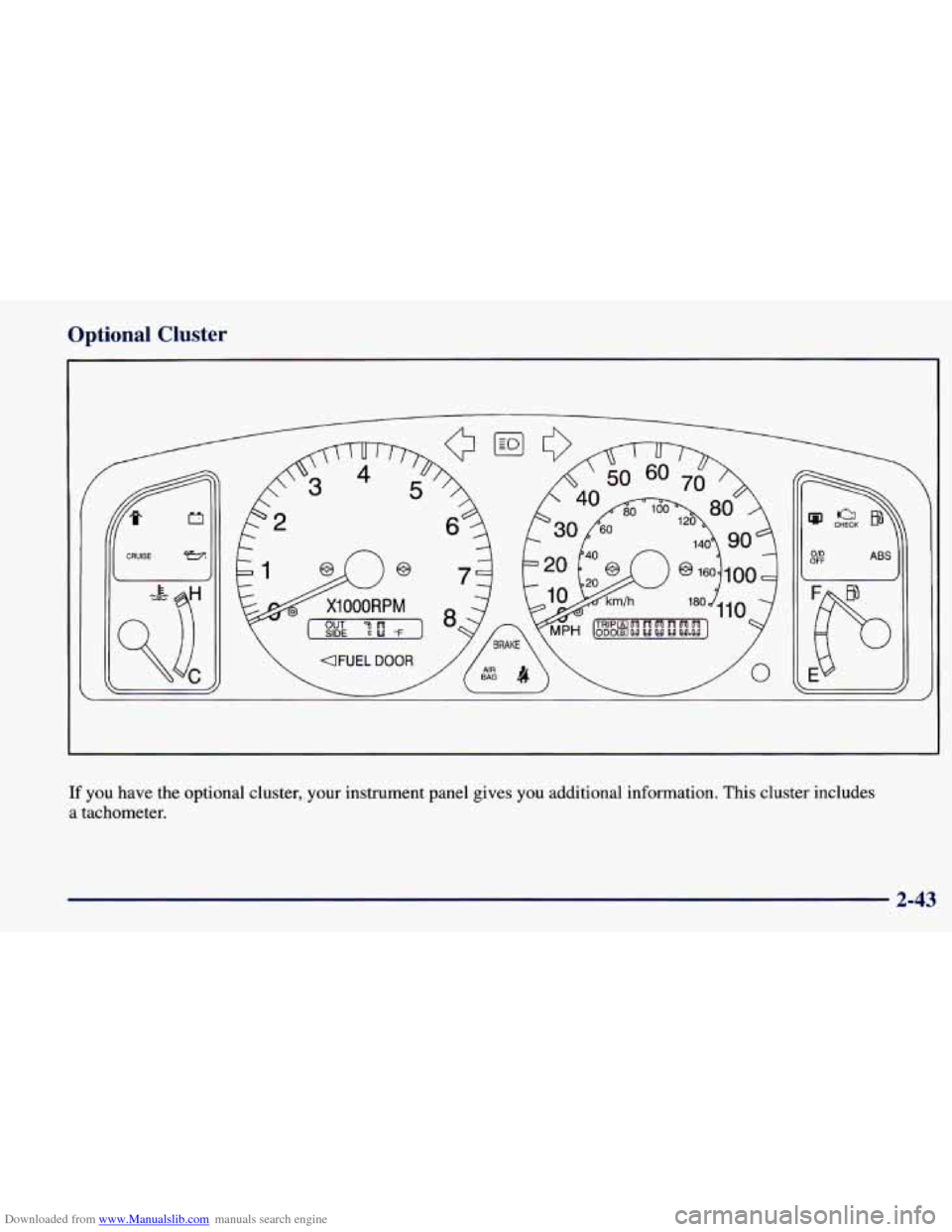
Downloaded from www.Manualslib.com manuals search engine Optional Cluster
R.2
n
X1000RPM
OUT [ SIDE 7 ! "F
4FUEL DOOR
OFF OD ABS 1
E P
If you have the optional cluster, your instrument panel gives you additional information. This cluster includes
a tachometer.
2-43
Page 127 of 364
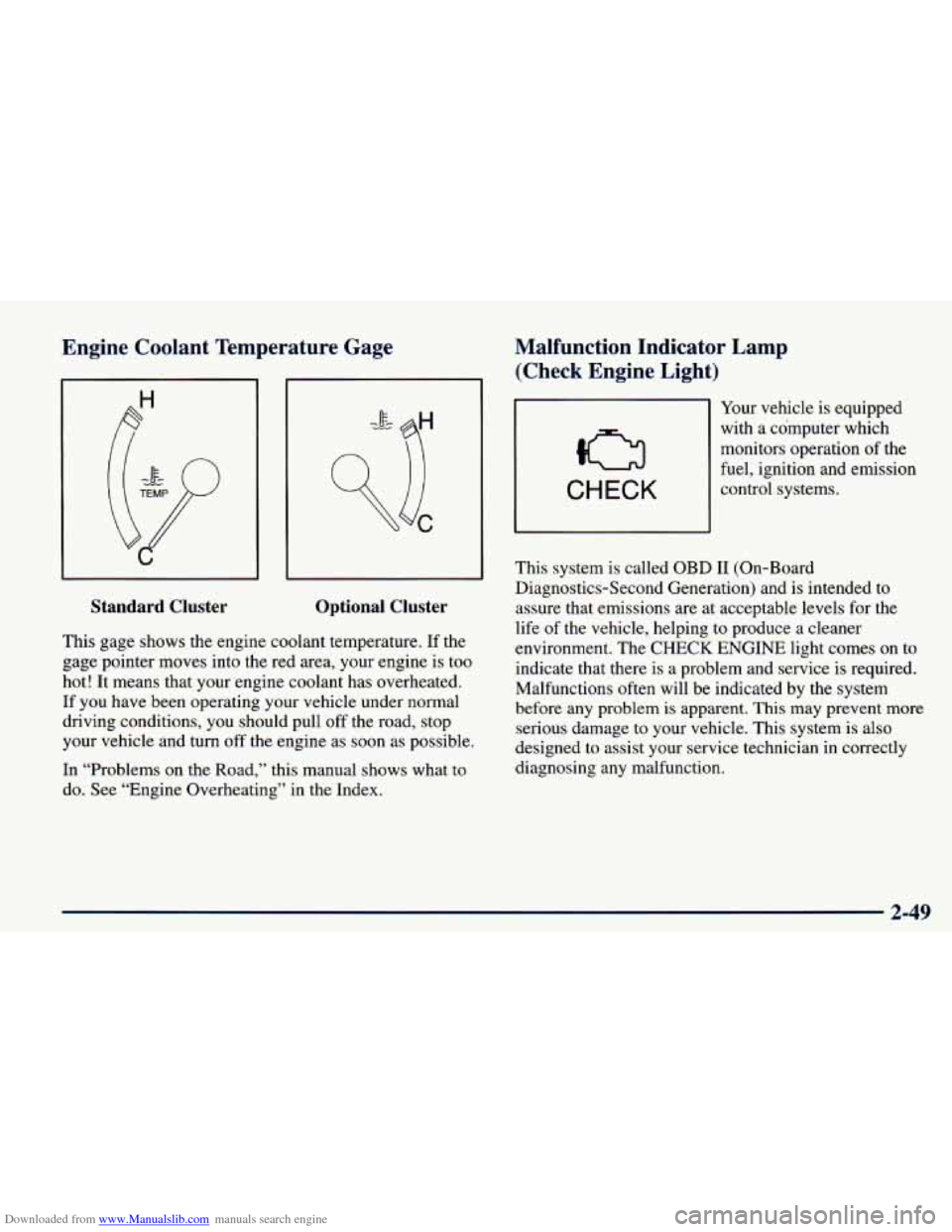
Downloaded from www.Manualslib.com manuals search engine Engine Coolant Temperature Gage Malfunction Indicator Lamp
(Check Engine Light)
TEMP
Standard Cluster Optional Cluster
This gage shows the engine coolant temperature. If the
gage pointer moves into the red area, your engine is too
hot! It means that your engine coolant has overheated.
If you have been operating your vehicle under normal
driving conditions, you should pull off the road, stop
your vehicle and
turn off the engine as soon as possible.
In “Problems on the Road,” this manual shows what to
do. See “Engine Overheating” in the Index.
~~ -~
tis
~~ Your vehicle is equipped
with a computer which
monitors operation of the
fuel, ignition and emission
control systems.
CHECK
This system is called OBD I1 (On-Board
Diagnostics-Second Generation) and
is intended to
assure that emissions are at acceptable levels for the
life
of the vehicle, helping to produce a cleaner
environment. The CHECK ENGINE light comes on to
indicate that there is a problem and service is required.
Malfunctions often will be indicated by the system
before any problem is apparent. This may prevent more
serious damage to your vehicle. This system
is also
designed to assist your service technician in correctly
diagnosing any malfunction.
2-49
Page 128 of 364
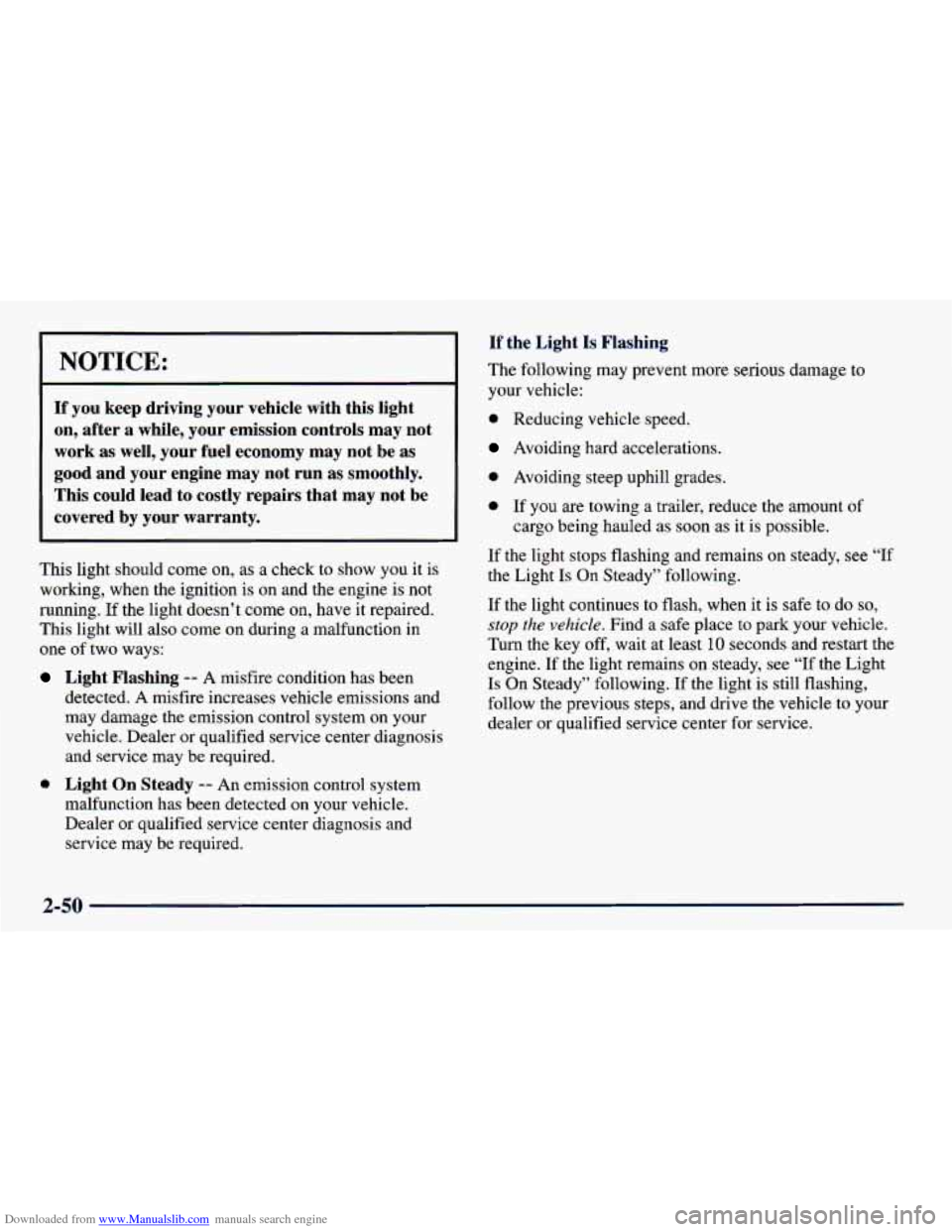
Downloaded from www.Manualslib.com manuals search engine NOTICE:
If you keep driving your vehicle with this light
on, after
a while, your emission controls may not
~ work as well, your fuel economy may not be as
good and your engine may not run as smoothly.
This could lead to costly repairs that may not be
covered
by your warranty.
This light should come on, as a check to show you it is
working, when the ignition is on and the engine
is not
running. If the light doesn’t come on, have it repaired.
This light will also come on during a malfunction in
one of two ways:
Light Flashing -- A misfire condition has been
detected.
A misfire increases vehicle emissions and
may damage the emission control system on your
vehicle. Dealer or qualified service center diagnosis
and service may be required.
@ Light On Steady -- An emission control system
malfunction has been detected on your vehicle.
Dealer or qualified service center diagnosis and
service may be required.
If the Light Is Flashing
The following may prevent more serious damage to
your vehicle:
0 Reducing vehicle speed.
Avoiding hard accelerations.
0 Avoiding steep uphill grades.
0 If you are towing a trailer, reduce the amount of
cargo being hauled as soon as it is possible.
If the light stops flashing and remains on steady, see “If
the Light Is
On Steady” following.
If the light continues to flash, when it is
safe to do so,
stop the vehicle. Find a safe place to park your vehicle.
Turn the key off, wait at least
10 seconds and restart the
engine. If the light remains on steady, see “If the Light
Is On Steady” following. If the light is still flashing,
follow the previous steps, and drive the vehicle to your
dealer or qualified service center for service.
2-50